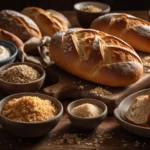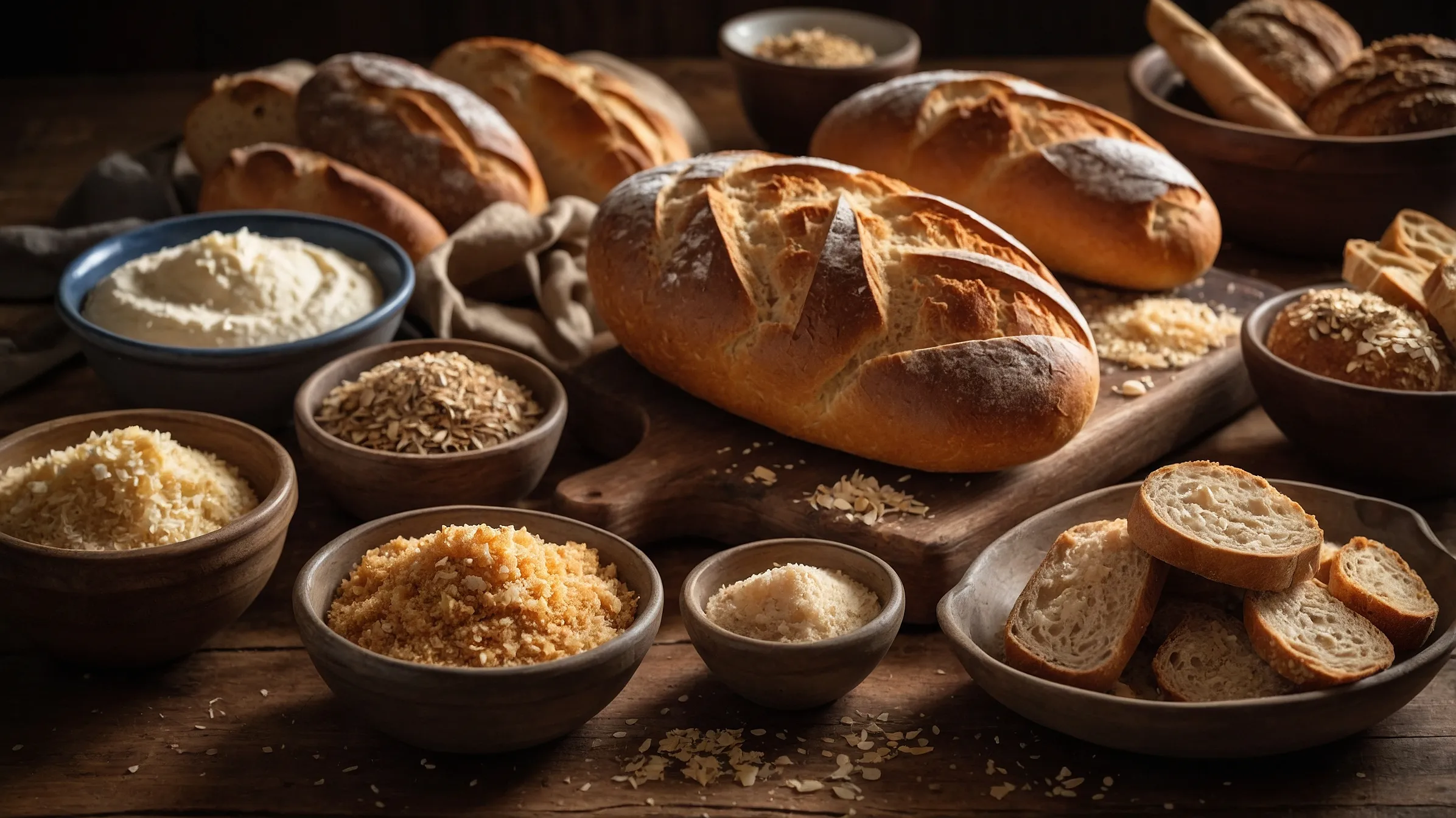Bread and crumbs—two simple yet indispensable ingredients—play a pivotal role in culinary traditions worldwide. From adding crunch to your favorite fried dishes to acting as a binding agent in meatballs, they’re true kitchen chameleons. This guide explores everything about bread and crumbs, including their types, uses, nutritional insights, and recipes, to help you master their potential.
Let’s dive into the fascinating world of bread and crumbs, starting with the basics.
Table of Contents
Introduction to Bread and Crumbs
What Are Bread and Crumbs?
Bread crumbs are small, processed pieces of bread, typically used in cooking to add texture, enhance flavor, or serve as a binding agent. They come in various forms, from fresh to dried and even finely processed varieties like panko. These crumbs can be made from any type of bread, offering endless possibilities for customization.
Bread itself, the foundation of crumbs, is a universal staple made by baking a dough of flour and water, often with additional ingredients like yeast, salt, or sweeteners. As bread ages or becomes stale, it finds new life in the form of bread crumbs—a sustainable and versatile culinary solution.
The History and Origin of Bread Crumbs
The concept of using bread crumbs dates back centuries, originating as a way to prevent food waste. Cultures worldwide discovered that stale bread could be crumbled, dried, and used in dishes ranging from soups to desserts. Panko bread crumbs, for example, have roots in Japanese cuisine, where they’re valued for their light, airy texture.
In European cuisine, bread crumbs have been a staple in recipes like schnitzels and meatloaves. Across the globe, they’ve become synonymous with creativity and thrift, transforming leftovers into culinary masterpieces.
Importance of Bread and Crumbs in Cooking
Why are bread and crumbs so vital in the kitchen? The answer lies in their versatility. Bread crumbs provide a crisp texture to fried dishes, absorb flavors in savory recipes, and act as a binder in preparations like meatballs or stuffing. They’re also used as a topping for baked dishes, creating a golden, crunchy layer.
Moreover, bread crumbs are a sustainable choice. Instead of discarding stale bread, repurpose it to reduce waste and make your meals more environmentally friendly. With endless applications, bread crumbs deserve a permanent spot in your pantry.
Where we’ll delve into the different types of bread and crumbs and how to choose the best one for your needs!
Types of Bread and Crumbs
Different Varieties of Bread Used for Crumbs

Bread crumbs start with bread, but not all bread is created equal. From white and whole wheat to sourdough and rye, each type of bread contributes a unique texture and flavor to the crumbs. White bread, for instance, produces neutral, versatile crumbs, while sourdough lends a tangy twist, perfect for gourmet dishes.
Artisan breads like ciabatta or baguettes create coarse, airy crumbs that mimic the texture of panko bread crumbs. Meanwhile, enriched breads like brioche or challah yield buttery, soft crumbs ideal for desserts and baked goods.
Types of Crumbs: Fresh, Dried, Panko, and More
- Fresh Bread Crumbs: These are made by processing soft, fresh bread and are perfect for recipes requiring moisture, such as meatloaf or stuffing.
- Dried Bread Crumbs: Produced by toasting or dehydrating bread, these crumbs are commonly used for coating fried foods like chicken or fish.
- Panko Crumbs: Originating from Japan, panko crumbs are coarser and lighter, providing unmatched crispiness in tempura and cutlets.
- Seasoned Crumbs: These often come pre-mixed with herbs and spices, ideal for enhancing dishes without additional preparation.
Choosing the Right Crumb for Your Dish
Selecting the right crumb can elevate your cooking. Use fresh crumbs for moist recipes and dried crumbs for crispy coatings. For a light, crunchy texture, panko bread crumbs are unmatched. Seasoned crumbs work wonders when time is short but flavor is essential. The type of crumb can make or break your dish, so choose wisely!
How to Make Bread Crumbs at Home
Step-by-Step Guide to Making Fresh Bread Crumbs
Making fresh bread crumbs is a breeze:
- Choose any soft bread (crust optional).
- Tear the bread into small chunks.
- Pulse in a food processor until the desired texture is reached.
Use these crumbs immediately or store them in an airtight container for up to three days in the refrigerator.
Techniques for Drying Bread Crumbs

To make dried bread crumbs:
- Preheat the oven to 300°F (150°C).
- Slice bread into thin strips and place on a baking sheet.
- Bake until fully dry but not browned (about 15 minutes).
- Cool completely and pulse in a food processor.
Dry crumbs can be stored in a sealed container for months, making them an economical choice.
Pro Tips for Storing Bread Crumbs
Proper storage ensures longevity and flavor:
- Fresh crumbs: Refrigerate in an airtight container.
- Dried crumbs: Store in a cool, dark pantry.
- Frozen crumbs: Place in freezer bags for up to six months.
Label your containers to track dates and types of crumbs. This method minimizes waste and ensures you always have the right crumbs on hand for any recipe.
For further inspiration on incorporating bread crumbs into meals, check out Panini Bread Tips and Recipes for creative ways to use enriched bread varieties!
Culinary Uses of Bread and Crumbs
Bread Crumbs in Main Dishes
Bread crumbs are a staple in many main dishes, adding texture and depth. From crispy fried chicken to tender fish fillets, bread and crumbs create a deliciously golden crust. Meatballs and meatloaves rely on bread crumbs to bind ingredients together, ensuring a moist, tender bite. For vegetarian options, bread crumbs are perfect for coating eggplant or zucchini for frying or baking.
Creative Uses in Appetizers and Sides
Don’t underestimate the versatility of bread crumbs in appetizers and side dishes. Sprinkle seasoned crumbs over baked mac and cheese for a crunchy topping, or use them to bind stuffing in mushrooms. They can also add a crispy finish to roasted vegetables or casseroles.
For those looking to experiment, try bread crumbs in non-traditional ways. For example, use toasted panko bread crumbs to garnish creamy soups or pasta dishes for added texture.
Bread Crumbs for Baking: Cakes and Desserts
Surprisingly, bread crumbs can elevate desserts too. They are often used in bread puddings, where they absorb rich custards for a decadent treat. For a twist, mix bread crumbs with nuts and sugar to form a crumbly topping for fruit crisps or tarts. Their neutral flavor makes them an excellent base for experimenting with creative dessert recipes.
For more delicious ideas on incorporating bread into your meals, explore our Peach Crumble Recipe, which creatively blends sweet flavors with a crumbly topping!
Nutritional Insights on Bread and Crumbs
Caloric and Nutritional Value of Bread Crumbs
Bread crumbs vary in nutritional content depending on the type of bread used. Fresh crumbs from whole-grain bread provide more fiber and nutrients than those from white bread. On average, one tablespoon of bread crumbs contains about 20 calories, making them a low-calorie way to add texture to your meals.
Panko bread crumbs are often preferred for their lower calorie and fat content compared to traditional crumbs. They’re lighter and absorb less oil, making them ideal for healthier cooking.
Healthier Alternatives for Bread Crumbs
For those watching their health, several substitutes for traditional bread crumbs are worth exploring. Almond flour, crushed oats, or even ground flaxseeds can mimic the binding and textural properties of crumbs while offering more nutritional benefits.
Gluten-free bread crumbs are also widely available, catering to those with dietary restrictions. They’re typically made from gluten-free breads like rice or chickpea flour.
Bread Crumbs in Gluten-Free Cooking
Cooking gluten-free doesn’t mean sacrificing flavor or texture. Gluten-free bread crumbs are perfect for creating crispy coatings, especially for fried foods. Additionally, homemade gluten-free crumbs allow you to customize flavors using herbs or spices.
Looking for more tips on healthy eating? Check out Toddler Lunch Ideas to inspire nutritious meals for your family!
Popular Recipes Using Bread and Crumbs
Classic Breaded Chicken and Fish Recipes
Bread and crumbs are the secret to achieving perfectly crispy fried chicken and fish fillets. Coat chicken breasts or fish fillets in seasoned bread crumbs before frying or baking. This not only locks in moisture but also creates that golden, crunchy crust everyone loves. Panko bread crumbs are especially great for achieving an extra-crispy texture.
For a healthier twist, use whole-grain or gluten-free crumbs and bake instead of frying. Pair breaded chicken or fish with a tangy dipping sauce for an irresistible combination.
Meatballs and Stuffings Enhanced with Crumbs

Meatballs are incomplete without bread crumbs. They act as a binder, soaking up moisture and keeping the meat tender. Mix bread crumbs with ground meat, eggs, and spices to create juicy, flavorful meatballs. Similarly, use crumbs in stuffing recipes for poultry or as a filling for vegetables like bell peppers or tomatoes.
Experiment with flavored or herb-seasoned bread crumbs to add depth to your recipes. The options are endless, from traditional Italian-style meatballs to vegetarian alternatives made with lentils or beans.
Vegetarian and Vegan Recipes with Bread Crumbs
Vegetarian dishes shine with the addition of bread crumbs. Use them to coat eggplant slices for crispy eggplant parmesan or to create a crusty topping for baked pasta. Vegan recipes can also benefit from bread crumbs—try them in plant-based burger patties, where they provide structure and hold everything together.
To add variety, toast the bread crumbs with garlic and olive oil for a flavorful topping that can elevate simple soups and salads.
FAQs on Bread and Crumbs
Can I Make Bread Crumbs from Any Bread?
Yes! Almost any bread can be transformed into bread crumbs. Whether it’s fresh or stale, white or whole grain, each type of bread produces unique crumbs. Even leftover sandwich bread can be used in a pinch. Just remember to adjust for flavor if you’re using specialty breads like sourdough or rye.
How Long Can I Store Homemade Bread Crumbs?
Fresh bread crumbs can last up to a week in the refrigerator, while dried crumbs can be stored in a cool, dry place for several months. If you freeze them, they’ll remain fresh for up to six months. Always store them in airtight containers to prevent moisture and contamination.
What Are the Best Substitutes for Bread Crumbs?
Great substitutes include crushed crackers, oats, almond flour, or even crushed cornflakes. Each offers a different texture and flavor, so choose one that complements your dish. For binding in recipes like meatballs, cooked quinoa or mashed potatoes work well.
Why Are Panko Crumbs So Popular?
Panko crumbs are light, airy, and less absorbent than traditional bread crumbs, making them ideal for frying. They create a crisp, golden coating without becoming greasy. Their popularity stems from their ability to provide the perfect texture while being versatile in various cuisines.
With these tips and recipes, you’re ready to explore the endless possibilities of bread and crumbs. For even more inspiration, check out our Ultimate Guide to Lunch Ideas for creative meal ideas!

Bread Crumbs Overview
Ingredients
For Making Fresh Bread Crumbs
- 1 loaf soft bread Crust optional
For Making Dried Bread Crumbs
- 1 loaf bread Any type of bread will work
For Panko and Seasoned Crumbs
- 1 cup panko bread crumbs Ideal for extra crispiness
- 1 cup seasoned crumbs Pre-mixed with herbs and spices
Instructions
Making Fresh Bread Crumbs
- Choose any soft bread (crust optional).
- Tear the bread into small chunks.
- Pulse in a food processor until the desired texture is reached.
- Use these crumbs immediately or store them in an airtight container for up to three days in the refrigerator.
Making Dried Bread Crumbs
- Preheat the oven to 300°F (150°C).
- Slice bread into thin strips and place on a baking sheet.
- Bake until fully dry but not browned (about 15 minutes).
- Cool completely and pulse in a food processor.

